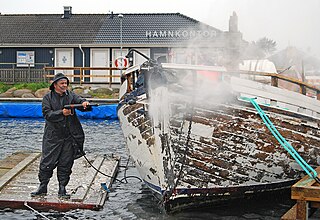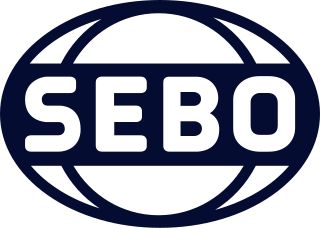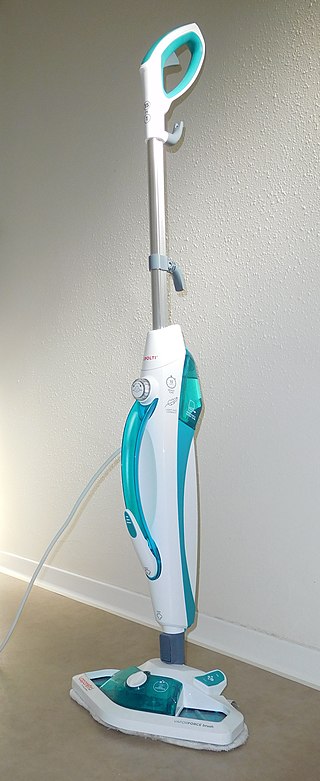
A vacuum cleaner, also known simply as a vacuum, or a hoover, is a device that uses suction in order to remove dirt and other substances from floors, upholstery, draperies, and other surfaces. It is generally electrically driven.

Cleaning is the process of removing unwanted substances, such as dirt, infectious agents, and other impurities, from an object or environment. Cleaning is often performed for aesthetic, hygienic, functional, safety, or environmental protection purposes. Cleaning occurs in many different contexts, and uses many different methods. Several occupations are devoted to cleaning.

Auto detailing is an activity that keeps the vehicle in its best possible condition, especially cosmetic, as opposed to mechanical. This is achieved by removing both visible and invisible contaminants from the vehicle's interior as well as polishing the exterior to its original blemish-free finish. The most basic detail options include an exterior wash and wax, interior vacuuming, window cleaning, and surface polishing.

A mop is a mass or bundle of coarse strings or yarn, etc., or a piece of cloth, sponge or other absorbent material, attached to a pole or stick. It is used to soak up liquid, for cleaning floors and other surfaces, to mop up dust, or for other cleaning purposes.

A car wash, or auto wash, is a facility used to clean the exterior, and in some cases the interior, of cars. Car washes can be self-service, full-service, or fully automated. Car washes may also be events where people pay to have their cars washed by volunteers, often using less specialized equipment, as a fundraiser.
The Kirby Company is a manufacturer of vacuum cleaners, home cleaning products and accessories, located in Cleveland, Ohio, United States. It is a division of Right Lane Industries. Dealers, sales reps, service centers, and distributors are located in over 50 countries. Kirby Vacuums are sold via door-to-door or though arranged-scheduled in-home demonstrations via their website and the company is a member of the Direct Selling Association, the Kirby website can also take vacuum cleaner orders and ship directly to the customer as well, without having to arrange for a scheduled an in-home demonstration. All Kirby Vacuum Cleaners are built in both Edgewater, Cleveland, Ohio and Andrews, Texas, United States

Pressure washing or power washing is the use of high-pressure water spray to remove loose paint, mold, grime, dust, mud, and dirt from surfaces and objects such as buildings, vehicles and concrete surfaces. The volume of a mechanical pressure washer is expressed in gallons or liters per minute, often designed into the pump and not variable. The pressure, expressed in pounds per square inch, pascals, or bar, is designed into the pump but can be varied by adjusting the unloader valve or using specialized nozzle tips. Machines that produce pressures from 750 to 30,000 psi or more are available.

Carpet cleaning is performed to remove stains, dirt, and allergens from carpets. Common methods include hot water extraction, dry-cleaning, and vacuuming.

An automated pool cleaner is a vacuum cleaner that is designed to collect debris and sediment from swimming pools with minimal human intervention.
The manual vacuum cleaner was a type of non-electric vacuum cleaner, using suction to remove dirt from carpets, being powered by human muscle, similar in use to a manual lawn mower. Its invention is dated to the second half of the 19th century, when patents were granted to inventors in the United States, Britain, France, and elsewhere.

SEBO is the brand name of vacuum cleaners made by Stein & Co GmbH, a company based in the German town of Velbert. They produce a range of upright and cylinder vacuum cleaners for domestic and commercial use. Sebo vacuum cleaners are endorsed by Allergy UK. Sebo stands for SEmigewerbliche BOdenpflege, German for semi-commercial floor care.

A cleaner or a cleaning operative is a type of industrial or domestic worker who does the cleaning.
Heat setting is a term used in the textile industry to describe a thermal process usually taking place in either a steam atmosphere or a dry heat environment. The effect of the process gives fibers, yarns or fabric dimensional stability and, very often, other desirable attributes like higher volume, wrinkle resistance or temperature resistance. Very often, heat setting is also used to improve attributes for subsequent processes.

Vapor steam cleaners or steam vapor systems are cleaning appliances or devices that use steam to dry, clean, and sanitize surfaces. The steam is produced in a boiler that heats tap water to high temperatures to produce low-pressure, low moisture water vapor.

Steam is water in the gas phase, and sometimes also an aerosol of liquid water droplets, or air. This may occur due to evaporation or due to boiling, where heat is applied until water reaches the enthalpy of vaporization. Steam that is saturated or superheated is invisible; however, wet steam, a visible mist or aerosol of water droplets, is often referred to as "steam".
Dry carpet cleaning involves the use of specialized machines to clean carpets with recently developed chemical technologies that permit no-moisture or "very low moisture" (VLM) cleaning, resulting in carpet beautification, and removal of stains, dirt, grit, sand, and allergens. Clean carpets are recognized by manufacturers as being more visually pleasing, potentially longer-lasting and probably healthier than poorly maintained carpets.
A truckmount carpet cleaner is a carpet and upholstery cleaning unit that is generally mounted to the floor of a van or trailer. Its cleaning method is hot water extraction. The operator would park the van near the premises, connect the vacuum hose and solution line hose into the machine, bring the hoses into the building, and connect a carpet cleaning wand to the end of the hoses.

A central vacuum cleaner is a type of vacuum cleaner appliance installed into a building as a semi-permanent fixture. Central vacuum systems are designed to remove dirt and debris from homes and buildings by sending dirt particles through piping installed inside the walls to a collection container in a remote utility space. The power unit is a permanent fixture, usually installed in a basement, garage, or storage room, along with the collection container. Inlets are installed in walls throughout the building that attach to power hoses and other central vacuum accessories to remove dust, particles, and small debris from interior rooms. Most power hoses have a power switch located on the handle.

A floor scrubber is a floor cleaning device. It can be a simple tool such as a floor mop or floor brush, or in the form of a walk-behind or a ride-on machine to clean larger areas by injecting water with cleaning solution, scrubbing, and lifting the residue off the floor. With advancements in robotics, autonomous floor-scrubbing robots are available as well.
















